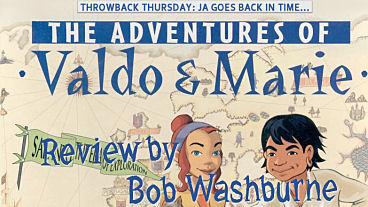
Throwback Thursday: The Adventures of Valdo and Marie







Note: This review was originally published August 20, 2004
Genre: Adventure
Release Date: Europe 1997 – Never released in America
Introduction:
The Adventures of Valdo and Marie is a delightful “edutainment” title from UbiSoft Entertainment, back before they became UbiSoft. It is now out of print and I found it difficult to get UbiSoft to even admit that they had ever heard of it. But it can still be found occasionally on eBay and at yard sales. I hope posting this review and a walkthrough will help lend it some well-deserved immortality.
The game was written for Windows 3.1, but I was able to play it under WinXP using compatibility mode and force 256 colors. Note: I found that you must set the compatibility and color options on the CD’s icon before it would allow you to install and then again on the game’s icon afterwards before it would allow you to play.
The game takes place in the 17th century, just before the Spanish Armada, back when Portugal dominated the seas. Valdo and Marie are two children who are traveling to Japan with their father and uncle aboard one of the most advanced ships of their day. Along the way they will have many adventures dealing with dangers and strange cultures.
The game’s ulterior motive is to teach the player something of the culture and technology of the 17th century. It claims to be suitable for children nine years old and up, but as an adult I found the puzzles to be quite challenging. So it should be enjoyable to all.
And for those of you have have been reading my other game reviews and are used to hearing me say how I didn’t enjoy the games, I have now broken the tradition and can honestly say I enjoyed playing this game very much. So my challenge now is to be careful not to overrate the game.
Gameplay
Exploration is the classic static slide show. The cursor changes shape when you hit a hotspot allowing you to move to another screen, talk to someone or interact with an object. The hotspots were large enough and the changes dramatic enough that I never had to go back and play Hunt-The-Pixel. So the Navigation was everything you would want it to be.
The gameplay is very linear. Some people might not like being forced to do things in a certain order, but I appreciated knowing what I was supposed to do next at any given time. There were only a couple of times when you had to go around and exhaust dialog trees to figure out what to do next. I normally don’t enjoy that, but it was minimal so it didn’t bother me.
There were a few dialog tree puzzles where you had to say the right thing to get the good response. They were fairly positive – rewarding polite behavior and punishing snotty behavior. So I was pleased with them.
The inventory based puzzles were well done. There were only a few items to carry in your inventory at any given time. They were easy to find and usually made sense to the puzzle. The only one that gave me fits was the larger puzzle of finding the pieces to the map throughout the game. To this day I have not found the last piece, but it may be due to a programming bug.
There were a good six or so twiddly puzzles. One was a variation of the old Sokoban and another was a variation on Lemmings. While both were straight forward in their solutions, they were timed which made them a bit tougher than they would have been otherwise. Fortunately, there is an option on the main menu that allows you to practice these puzzles outside of the game. All of them were quite enjoyable, although I have a hard time believing that a nine year old could finish these unaided.
One frustrating part of the gameplay was that it was possible to go to the next scene before you had finished the current scene successfully. In fact, if you failed some puzzles you would be taken to the next scene with no opportunity to go back and try again. Fortunately, you have ample opportunity to save games and restore to try again later. This is a little different than the classic problem of dying in a game since you don’t always know that there was more to do before you move on. Then you are stuck trying to figure out what you are missing, where you missed it, and which saved game takes the closest to it.
One gripe I had was that there are two different good endings to the game. But to get to the second ending you must let a certain puzzle time out without solving it. This will take you to a continent that you otherwise would never visit. But there is no indication that this is a timed puzzle – it looks like any other part of the game. And it takes 8 minutes for the timeout. What nine year old is going to wait that long? I suspect only people with a walkthrough would find this solution.
My final gripe was that last piece of the map. I finally stumbled upon a walkthrough in German (I suspect that mine will be the first in English) which indicated that you get the last piece from a guru in India who will send you back in time. I go to the guru and he offers to send me back in time. I agree and he then just sits there staring at me. Nothing happens. After 45 minutes nothing happens. And there are no hotspots on the screen except for an exit. So either this is a bug, a WinXP incompatibility, or something so sneaky that only a nine year old could figure it out. If someone has actually completed this, please let me know how it is supposed to work so I can update both this review and the walkthrough. Thanks!
I give gameplay a solid “B+.”
Story
The storyline is right in line with what you would expect. The classic dangers are encountered; navigation, storms, pirates, foreign cultures who are insulted by the strangest things. Although things were a little tamed down for the children, I could believe a young boy could be taken along. Cabin boys were about Valdo’s age. But a young girl? It was bad luck to let a woman on board, so Marie’s presence is a bit of an anachronism.
The pirates were rather bloodless – a big battle takes place and nobody has a scratch to show for it. Then you get rid of them by proving you are friends with a friend of the first mate. Not exactly historical, but better than subjecting nine year olds to impaling and torture.
But all in all the story was quite reasonable for its intended purpose. I give it another “B+.”
Education
Will you actually learn something from playing this game?
Well, I personally learned that these Portuguese ships were steered via a long lever as opposed to the familiar ship’s wheel. There were many other such tidbits which helped make history come alive.
By the end of the game you will be very familiar with the layout of the ship and the purpose of its various decks and holds.
Some of the puzzles also emphasized just how dependent the old ships were on wind and current.
The game also does a good job in teaching that actions have consequences, some of which might not show up until a long time later. Decisions made early in the game could affect its outcome.
You won’t come out of this game as an expert of 17th century sailing, but you will have a greater appreciation of what people back then had to go through. Which, to my way of thinking, gives it a “B.”
Graphics
Cartoon in the style made popular by Lucas Arts. All well done. Nothing outstanding. Nothing to complain about. Excellent characterization of the people. A solid “B+.”
Sound
Good sounds. Good music. Good voice acting (it even sounded like a Saturday morning cartoon with fast talking trying to fit within the lip movement).
Nothing outstanding. Nothing to complain about. A solid “B+.”
Addictability
Good. Yes, I wanted to finish it. Yes, I lost some sleep over it. Yes, I want to play it again to the sake of writing a walkthrough. No, my job was never threatened by it. Another solid “B.”
Conclusion
Finally! I review a game I actually enjoyed playing. And it was written for nine year olds. Hmmm, I wonder what that says about me…
Anyway, I suggest you keep an eye out for this game, wherever you find your old abandoned games. It was fun. I learned a little. And I’m always impressed when someone actually creates a new Sokoban puzzle.
But as much as I enjoyed it, I will stick to my guns. To rate an “A” a game must either set a new standard of excellence or totally nail the current standard. A’s should be rare. So without hesitation I award this classic oldie a “B+.”
Final Grade: B+
System Requirements:
- 486DX 66 MHz
- 2X CD-ROM drive
- 8 Mb RAM
- Microsoft Windows 3.1/95/98
- VGA video card, 640×480 at 256 colors
- Sound card

Leave a Reply